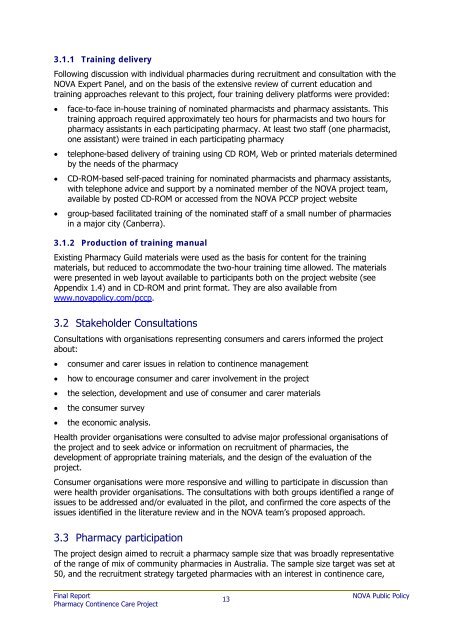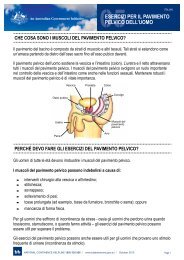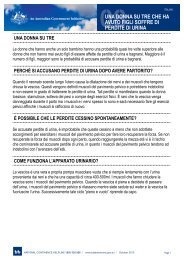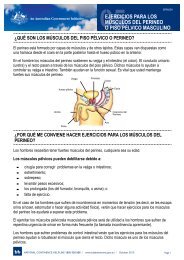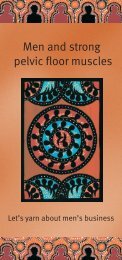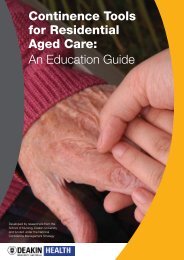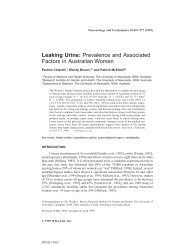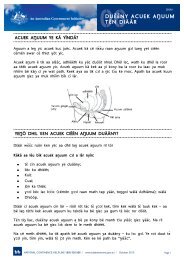Pharmacy Continence Care - Bladder and Bowel Website
Pharmacy Continence Care - Bladder and Bowel Website
Pharmacy Continence Care - Bladder and Bowel Website
You also want an ePaper? Increase the reach of your titles
YUMPU automatically turns print PDFs into web optimized ePapers that Google loves.
3.1.1 Training delivery<br />
Following discussion with individual pharmacies during recruitment <strong>and</strong> consultation with the<br />
NOVA Expert Panel, <strong>and</strong> on the basis of the extensive review of current education <strong>and</strong><br />
training approaches relevant to this project, four training delivery platforms were provided:<br />
• face-to-face in-house training of nominated pharmacists <strong>and</strong> pharmacy assistants. This<br />
training approach required approximately teo hours for pharmacists <strong>and</strong> two hours for<br />
pharmacy assistants in each participating pharmacy. At least two staff (one pharmacist,<br />
one assistant) were trained in each participating pharmacy<br />
• telephone-based delivery of training using CD ROM, Web or printed materials determined<br />
by the needs of the pharmacy<br />
• CD-ROM-based self-paced training for nominated pharmacists <strong>and</strong> pharmacy assistants,<br />
with telephone advice <strong>and</strong> support by a nominated member of the NOVA project team,<br />
available by posted CD-ROM or accessed from the NOVA PCCP project website<br />
• group-based facilitated training of the nominated staff of a small number of pharmacies<br />
in a major city (Canberra).<br />
3.1.2 Production of training manual<br />
Existing <strong>Pharmacy</strong> Guild materials were used as the basis for content for the training<br />
materials, but reduced to accommodate the two-hour training time allowed. The materials<br />
were presented in web layout available to participants both on the project website (see<br />
Appendix 1.4) <strong>and</strong> in CD-ROM <strong>and</strong> print format. They are also available from<br />
www.novapolicy.com/pccp.<br />
3.2 Stakeholder Consultations<br />
Consultations with organisations representing consumers <strong>and</strong> carers informed the project<br />
about:<br />
• consumer <strong>and</strong> carer issues in relation to continence management<br />
• how to encourage consumer <strong>and</strong> carer involvement in the project<br />
• the selection, development <strong>and</strong> use of consumer <strong>and</strong> carer materials<br />
• the consumer survey<br />
• the economic analysis.<br />
Health provider organisations were consulted to advise major professional organisations of<br />
the project <strong>and</strong> to seek advice or information on recruitment of pharmacies, the<br />
development of appropriate training materials, <strong>and</strong> the design of the evaluation of the<br />
project.<br />
Consumer organisations were more responsive <strong>and</strong> willing to participate in discussion than<br />
were health provider organisations. The consultations with both groups identified a range of<br />
issues to be addressed <strong>and</strong>/or evaluated in the pilot, <strong>and</strong> confirmed the core aspects of the<br />
issues identified in the literature review <strong>and</strong> in the NOVA team’s proposed approach.<br />
3.3 <strong>Pharmacy</strong> participation<br />
The project design aimed to recruit a pharmacy sample size that was broadly representative<br />
of the range of mix of community pharmacies in Australia. The sample size target was set at<br />
50, <strong>and</strong> the recruitment strategy targeted pharmacies with an interest in continence care,<br />
Final Report<br />
13<br />
NOVA Public Policy<br />
<strong>Pharmacy</strong> <strong>Continence</strong> <strong>Care</strong> Project


